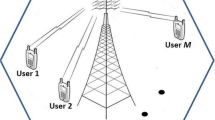Abstract
Two generalized constructions of single-symbol maximum likelihood (ML) decodable space-time block codes (SSDCs), the coordinate interleave orthogonal design (CIOD) and the generalized CIOD (GCIOD), have been proposed by Khan et al. Their main disadvantage is that there are too many zero entries in the codeword matrix. The transmission of these zero-valued symbols causes switching off some of the transmit antennas resulting in a high peak-to-average power ratio and also imposing a severe constraint on hardware implementation of the code. Based on the orthogonal construction of orthogonal space-time block codes and coordinate interleaving, a new generalized construction of SSDCs is proposed. Our proposed codes not only maintain the desirable properties of high rate, full transmit diversity and single-symbol ML decoding similar to CIODs and GCIODs, but also have fewer zero entries in its codeword matrix than CIODs and GCIODs.
Similar content being viewed by others
References
Alamouti S. M. (1998) A simple transmitter diversity scheme for wireless communications. IEEE Journal on Selected Areas in Communications 16: 1451–1458
Tarokh V., Jafarkhani H., Calderbank A. R. (1999) Space-time block codes from orthogonal designs. IEEE Transactions on Information Theory 45: 1456–1467
Lu K., Fu S., Xia X.-G. (2005) Closed-form designs of complex orthogonal space-time block codes of rates (k + 1)/2k for (2k−1) or 2k transmit antennas. IEEE Transactions on Information Theory 51: 4340–4347
Khan M. Z. A., Rajan B. S. (2006) Single-symbol maximum-likelihood decodable linear STBCs. IEEE Transactions on Information Theory 52(5): 2062–2091
Yuen C., Guan Y. L., Tjhung T. T. (2008) Power-balanced orthogonal space-time block code. IEEE Transactions on Vehicular Technology 57(5): 3304–3309
Karmakar, S., & Rajan, B. S. (2006). Minimum-decoding-complexity maximum-rate space-time block codes from Clifford algebras. In Proceedings of IEEE ISIT, Seattle, USA, pp. 788–792.
Dao D. N., Yuen C., Tellambura C., Guan Y. L., Tjhung T. T. (2008) Four-group decodable space-time block codes. IEEE Transactions on Signal Processing 56: 424–430
Wang H., Wang D., Xia X. G. (2009) On optimal quasi-orthogonal space–time block codes with minimum decoding complexity. IEEE Transactions on Information Theory 55(3): 1104–1130
Sinnokrot M. O., Barry J. R. (2009) A single-symbol-decodable space-time block code with full rate and low peak-to-average power ratio. IEEE Transactions on Wireless Communications 8(5): 2242–2246
Ankita, P., & Rajan, B. S. (2010). No-zero-entry, square, single-symbol ML decodable STBCs. NCC 2010, 2010 National Conference on Communication, Chennai, India, 29–31 January.
Das, S., & Rajan, B.S. (2008). Square complex orthogonal designs with no zero entry for any 2m antennas. Available on http://arxiv.org/PS_cache/arxiv/pdf/0812/0812.2458v1.pdf, December 2008.
Das S., & Rajan B. S. (2008). A class of maximal-rate, low-PAPR, non-square complex orthogonal designs. Available on http://arxiv.org/abs/0808.1400v1 August 2008.
Tarokh V., Seshadri N., Calderbank A. R. (1998) Space-time codes for high data rate wireless communication: performance criterion and code construction. IEEE Transactions on Information Theory 44(2): 744–765
Dao, D. N., & Tellambura, C. (2008). Decoding, performance analysis, and optimal signal designs for coordinate interleaved orthogonal designs. IEEE Transactons on Wireless Communications, 7(1).
Author information
Authors and Affiliations
Corresponding author
Rights and permissions
About this article
Cite this article
Pham, VB., Sheng, W., Wang, M. et al. Single-Symbol Maximum Likelihood Decodable STBCs with Fewer Zero-Entries. Wireless Pers Commun 69, 827–839 (2013). https://doi.org/10.1007/s11277-012-0614-6
Published:
Issue Date:
DOI: https://doi.org/10.1007/s11277-012-0614-6




